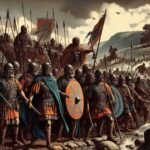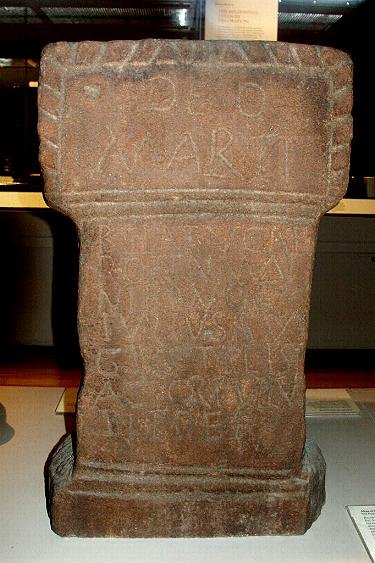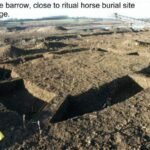Roman Sites in Southern BritainThe Gazetteer is organised by Counties and unitary authorities, preceded by summaries of groups of sites: frontiers and industrial areas. The Channel Islands are listed at the end of this section. Frontiers and industrial areas • Channel Islands • Buckinghamshire • Cornwall • Devon • Dorset • Essex • Gloucestershire • Hampshire • Hertfordshire • Kent • London • Norfolk • City of Plymouth • City of Portsmouth • North Somerset • Somerset • Suffolk • Surrey • East Sussex • West Sussex • Swindon • Wiltshire •
|
||
| FRONTIERS AND INDUSTRIES |
Saxon Shore | Ten forts (Brancaster, Burgh Castle, Walton Castle, Bradwell, Reculver, Richborough, Dover, Lympne, Pevensey and Portchester) are known, built from the mid 3rd to the early 4th century, that housed the garrison that is listed as being under the command of the Duke of the Saxon Shore in the Notitia Dignatatum. If it functioned as a frontier system there must have been a series of watch towers and signal stations to communicate between the forts, but none are known. A contrary view is that the sites are fortified harbours rather than a Limes.
Not all the sites in the Notitia have been definately identified with the known sites. Similar forts are known in Wales – Cardiff and Caer Gybi – and at Lancaster in northern england; see Norfolk, Suffolk, Essex, Kent and East Sussex for detailed entries Maxfield (ed), The Saxon Shore: A Handbook, Exeter 1989 Cotterill, J., Saxon raiding and the role of the late Roman coastal forts of Britain, in Britannia XXIV, 1993, pp227–239 Jones, The End of Roman Britain, New York 1996 |
| Blackdown Hills Iron | Roman involvement, circa 50-70AD, in iron extraction and smelting in the Blackdown Hills that straddle the Somerset/Devon border has been suggested as one reason for the concentration of military sites in the area. See Devon and Somerset.Griffith, F. M. and Weddell, P. J., Ironworking in the Blackdown Hills in The Archaeology of Mining in South West England, Historical Metallurgy Society Conference Proceedings, 1996 | |
| Wealdon Iron Industry | The presence of tiles stamped CL BR indicates that the Classis Britannica was closely involved in at least part of the iron industry in the Weald. Only sites with a strong claim to military involvement are listed, see East Sussex and Kent for detailed entries. Cleere, The Roman Iron Industry of the Weald and its connections with the Classis Britannica, in The Archaeological Journal Volume 131, 1975, pp171-99
|
|
| Mendip Silver and Lead | Lead from the Mendips was extracted by the army under Claudius and Nero. By the early 60s AD operations may have been under civilian control. See Avon and Somerset for detailed entries. Elkington, The Mendip Lead Industry in Branigan and Fowler (eds), The Roman West Country, Newton Abbot, 1976, pp183-97
Whittick, The earliest Roman lead mining on Mendip and in North Wales: a reappraisal, Britannia XIII, 1982, pp113-23 |
|
| CHANNEL ISLANDS |
The Nunnery Alderney WA 5908 |
Late Roman fortlet? similar to those on the Yorkshire coast Johnson, S., The Forts of the Saxon Shore, London 1976, p81 |
| BUCKINGHAMSHIRE |
Cow Roast SP9510 |
Fort? Britannia VII, 1976, pp338-9 |
| Dropshort Magiovinium SP8833 |
Site with two forts both pre-Flavian? Woodfield, in Records of Buckinghamshire XX, 1977, pp384-399 | |
| Walton Court SP8118 |
Fort? Records of Buckinghamshire XXIII, 1981, pp384-399 | |
| CORNWALL | Carvoda SX3478 |
Fortlet? Griffith, F. M., Developments in the study of Roman military sites in South West England, Roman Frontier Studies 1996, Oxbow, pp361-367 |
| Carvossa SW9148 |
Roman military presence? Quinnel, H., Cornwall during the Iron Age and Roman Period, Cornish Archaeology 25, 1986 | |
| Morwenstow SS2014 |
Fortlet? Herring, P., Stretton Hundred, Rapid Identification Survey, Cornish Archaeology 33, 1994 | |
| Nanstallon SX0367 |
1.0 ha fort built around 50 AD and abandoned by early 80s AD. Britannia III, 1972, pp56-111 | |
| St Gennys SX1394 |
Fortlet? Herring, P., Stretton Hundred, Rapid Identification Survey, Cornish Archaeology 33, 1994 | |
| DEVON | Alverdiscott SS4925 |
Small pre-Flavian marching camp Journal of Roman Studies LXVII, 1972, p126 |
| Axminster SY2997 |
Neronian – Flavian(?) fort, c 2.5 ha Silvester and Bidwell, A Roman site at Woodbury, Axminster, Proceedings of the Devon Archaeological Society 42, 1984, pp33-57 | |
| Broadbury SX4895 |
Fortlet? Griffith, F. M., Developments in the study of Roman military sites in South West England, in Roman Frontier Studies 1995, 1997 | |
| Broadclyst see Killerton |
||
| Bury Barton SS7307 |
Large pre-Flavian fort that was succeeded by a smaller one that in turn was abandoned early in the Flavian period. Todd, The Roman fort at Bury Barton, Devonshire, Britannia 16, 1985 pp1-7 | |
| Clayhanger ST0021 |
Fort of 1.1 ha Griffith, F. M., Aerial Reconnaissance in Mainland Britain in the Summer of 1989, Antiquity 64, 1990 | |
| Colebrooke SS7700 |
Fort? Griffith, F. M., Devon’s Past: An Aerial View, Exeter 1988 | |
| Cullompton ST0107 |
Site with two forts of mid to late 1st century date; the second fort was probably the larger Griffith, F. M., Roman Military Sites in Devon: Some recent discoveries, PDAS, 1984 | |
| Exeter Isca Dumnoniorum SX9192 |
Legionary fortress, 15.4 ha, built c 55 AD and retained by the army until the late 1st century. Most of the garrison may have left c 66AD. Garrisoned by Legio II Augusta but with accommodation for two ala (?).Exeter is the smallest permanent fortress known in Britain and, compared to the other fortresses, conditions for its garrison if the legion was ever present at full strength must have been dreadfully cramped.
Bidwell, Roman Exeter: Fortress and Town, Exeter, 1980 |
|
| Hembury ST1103 |
Fort? Todd, M., Hembury (Devon): Roman troops in a hillfort, Antiquity 58, 1984, pp171-4 | |
| Higher Kingdon See Alverdiscott |
||
| Ide SX8888 |
Fortlet Griffith, Roman military sites in Devon: some recent discoveries, Proceedings of the Devon Archaeology Society 42, 1984, pp11-32 | |
| Killerton SS9700 |
Fort? Griffith, F. M., Roman Military Sites in Devon: Some recent discoveries, Proceedings of the Devon Archaeology Society 42, 1984 | |
| Lapford see Bury Barton |
||
| Martinhoe SS6649 |
Neronian fortlet, 0.1 ha. Took over the role of Old Burrow? Occupied into the late 1st century. Fox, Martinhoe and Old Burrow, Antiquity 39, 1965, pp253-8
|
|
| Newton Tracey SS5326 |
Fortlet or watch tower? Griffith, F. M., Roman Military Sites in Devon: Some recent discoveries, Proceedings of the Devon Archaeology Society 42, 1984 | |
| North Tawton SX6699 |
2.6 ha fort of mid 1st century date, with annex. Also a two phase fortlet? that was reduced from 0.6 ha? Griffith, F. M., Roman Military Sites in Devon: Some recent discoveries, Proceedings of the Devon Archaeology Society 42, 1984 | |
| SX6600 | Two? marching camps Griffith, F. M., Roman Military Sites in Devon: Some recent discoveries, Proceedings of the Devon Archaeology Society 42, 1984 | |
| Okehampton SX5996 |
1.3 ha fort of mid 1st century? date that was held until c 80 AD. Fortlet
Bidwell, P.T., et al, The Roman Fort at Okehampton, Devon, Britannia 10,1979 Griffith, F. M., Roman Military Sites in Devon: Some recent discoveries, Proceedings of the Devon Archaeology Society 42, 1984 |
|
| Old Burrow SS7849 |
Claudian fortlet, 0.1 ha. Its role taken by Martinhoe in Nero’s reign ? Fox, Martinhoe and Old Burrow, Antiquity 39, 1965, pp253-8 | |
| Pomeroy Wood SY1399 |
Military site exact type and purpose described as unknown by the excavator, suggested occupation period of mid-60s-80AD.Fitzpatrick, Butterworth, Grove, Prehistoric & Roman Sites in East Devon: the A30 Honiton to Exeter Improvement DBFO scheme, 1996-9, Wessex Archaeology, Salisbury 1999 | |
| Seaton SY2490 |
Military presence? Griffith, F. M., Trial excavations at Honeyditches and the nature of the Roman occupation of Seaton, Proceedings of the Devon Archaeological Society 45, 1987 | |
| Stoke Hill SX9295 |
Pre-Flavian fortlet Fox and Ravenhill, The Stoke Hill Signal Station, excavations 1957-7, Report and Transactions the Devonshire Association 91, 1959, pp71-82 | |
| Sourton Down SX5491 |
Fortlet or English Civil War earthwork? Griffith, F. M., Developments in the study of Roman military sites in South West England, Roman Frontier Studies 1996, Oxbow, pp361-367 | |
| Tiverton SS9514 |
1.5 ha, fort, with two occupation periods c 65 AD and early 70s Maxfield, V., Tiverton Roman Fort Excavations 1981-1986, in Proceedings of the Devon Archaeology Society 49, 1991 | |
| Woodbury see Axminster |
||
| DORSET |
Black Down see Winterbourne Steepleton |
|
| Candy’s Farm SY9998 |
Possible signal station? Field, N., Dorset and the Second Legion: new light on a Roman campaign, Dorset Books, 1992 pp139-143 | |
| East Holton SY9591 |
Possible forts?Field, N., Dorset and the Second Legion: new light on a Roman campaign, Dorset Books, 1992 pp143-147 | |
| Dorchester Durnovaria SY6890 |
Pre-Flavian fortress of II Augusta? Hassall, M., Pre-Hadrianic legionary dispositions in Roman Fortresses and their legions, ed Brewer, London & Cardiff 2000 | |
| Hamworthy SZ0090 |
Pre-Flavian military harbour. A depot for the Lake Farm fortress? Proceedings of the Dorset Natural History and Archaeological Society 95, 1975, pp86-7 | |
| Hod Hill ST8510 |
1.8 ha pre-Flavian fort in a hillfort. Garrisoned by part of Legio II Augusta and auxiliaries? Richmond, I., Excavations carried out at Hod Hill between 1951 and 1958 vol II, London, 1968
|
|
| Keynston Down ST9205 |
Possible fortlet? Proceedings of the Dorset Natural History and Archaeological Society 1976 volume 98, pp 65-7 | |
| Lake see Lake Farm |
||
| Lake Farm SY9899 |
11.7 ha pre-Flavian fortress with two occupation periods. Garrisoned by Legio II Augusta.
Field, N., Dorset and the Second Legion, Devon, 1992 |
|
| Shapwick ST9402 |
2.4 ha fort?
Papworth, M., The Roman-British Settlement at Shpawick, Dorset, Britannia XXVIII, 1997, pp354-358 |
|
| Waddon Hill ST4401 |
Pre-Flavian fort in a hillfort. Garrison may have included part of Legio II Augusta?
Proceedings of the Dorset Natural History and Archaeological Society LXXXII, 1960, pp88-108 |
|
| Winterbourne Steepleton SY6088 |
Fortlet? Proceedings of the Dorset Natural History and Archaeological Society LXXXXII, 1970, pp140-141 | |
| ESSEX |
Bradwell Othona TM0308 |
Saxon Shore fort, in the late 4th century garrisoned by Numerus Fortensium. Maxfield (ed), The Saxon Shore: A Handbook, Exeter 1989 |
| Chelmsford Caesaromagus TL7006 |
Claudian fort Rodwell-Rowley, Transactions of the Essex Archaeological Society, 1975 pp159-73 | |
| Colchester Camulodunum TL9925 |
Claudian legionary fortress, 20 ha that was abandoned c 49 AD when its, garrison, Legio XX Valeria Victrix, moved to Kingsholm. Crummy Britannia VIII (1977) pp65-105 | |
| Fingringhoe Wick TM0519 |
Claudian military harbour associated with the Colchester fortress? Britannia I, 1970, p181 | |
| Great Chesterford TL5043 |
Neronian? small fortress, 14.2 ha. If the dating is correct the site may be associated with the Boudica rebellion. Britannia III, 1972, pp290-3 | |
| Kelvedon Canonium TL8618 |
Pre-Flavian fort Britannia V, 1974, pp442-3 | |
| Stanway TL9622 |
Claudian fort, c 2.0 ha, garrisoned by Ala I Thracum? Close to Colchester, the fort was probably founded before the legionary fortress. Webster, The Roman Invasion of Britain, 1980, pp129-130 | |
| GLOUCESTERSHIRE | Cirencester Corinium Dobunnorum SP0201 |
Two successive forts of mid – late 1st century the garrisons of which are unknown. The names of units recorded at Cirencester come from two gravestones that are not linked to the forts – Ala Indiana Gallorum (mid or late 1st century?) and Ala I Thracum (late 1st century). Wacher and McWhirr, Cirencester Excavations I, 1981 and Cirencester Excavations II, 1982 |
| Gloucester Glevum SO8318 |
Fort? of pre-Flavian date, occupied by Cohors VI thracum Equitata? (see Kingshom). Neronian fortress, 17 ha, garrisoned by Legio XX c67- 75 AD.
Britannia XI, 1980, pp73-114 Hassall, M., Pre-Hadrianic legionary dispositions in Roman Fortresses and their legions, ed Brewer, London & Cardiff 2000 |
|
| Kingsholm SO8319 |
Fort? of pre-Flavian date, occupied by Cohors VI thracum Equitata? (see Gloucester) Claudian fortress, occupied by Legio XX Valeria Victrix and abandoned when the legion moved to Usk late 50s AD.
Britannia XI, 1980, pp73-114 |
|
| HAMPSHIRE |
Silchester SU6561 |
Claudian Legionary fortress of II Augusta?Hassall, M., Pre-Hadrianic legionary dispositions in Roman Fortresses and their legions, ed Brewer, London & Cardiff 2000 |
| HERTFORDSHIRE |
Northchurch SP9709 |
Military presence?Hertfordshire Archaeology IV, 1974-6 |
| St Albans Verulamium TL1307 |
Early Claudian fort, abandoned c 49 AD? when Legio XX’s army group moved to the south-west Midlands. Frere, Verulamium Excavations I, Oxford, 1971 and Verulamium Excavations II, London, 1983 | |
| KENT | Dover Dubris TR3141 |
Fort for the Classis Britannica started c 117 AD, but never finished. A second also for the fleet was built c 130 AD. Occupation of the site by the navy appears to be linked with periods of relative peace in northern Britain when the fleet was concentrated in the south. A third fort dates from the late 3rd century and was part of the Saxon Shore. Its garrison during the late 4th century was Milites Tungrecani. Philp, The excavations of the Roman forts of the Classis Britannica at Dover 1970-77, Dover 1981 |
| Folkestone TR2136 |
Villa site where tiles produced by Classis Britannica suggest a connection with the fleet, possibly the Prefect’s house? The site has been destroyed by sea erosion. Philp, The excavations of the Roman forts of the Classis Britannica at Dover 1970-77, Dover 1981 | |
| Little Farningham Farm TQ8035 |
Iron working site? Tiles produced by Classis Britannica found on the site. Cleere, The Roman Iron Industry of the Weald and its connections with the Classis Britannica, in The Archaeological Journal Volume 131, 1975, pp171-99 | |
| Lympne Portus Lemanis TR1134 |
Fort? garrisoned by the Classis Britannica late 1st – early 2nd centuries. Saxon Shore fort occupied late 3rd – 4th centuries and garrisoned by Numerus Turnacensium (late 4th century). Britannia XI, 1980, pp227-88 | |
| Reculver Regulbium TR2269 |
Small Claudian fort? that was succeeded by a Flavian fort. Saxon Shore fort built during the 3rd century and garrisoned by Cohors I Baetasiorum civium Romanorum ob virtutem et fidem. Philp, The Roman fort at Reculver, Dover, 1970 | |
| Richborough Rutupiae TR3260 |
Claudian temporary camp, the bridgehead fort(?) for the invasion in 43 AD, though not large enough for the whole army. This temporay camp was succeeded by a stores base. In the mid 3rd century century a triumphal arch (erected in the late 1st century to mark the completion of the conquest of Britain) was converted into a watch tower. The tower was demolished when the Saxon Shore fort was built at the end of the 3rd century.
During the 4th century the garrison was the successor to the Legio II Augusta (Legio Secundes Britones) now reduced to the typical late-Empire sized legion of more than 1,000. Britannia II, 1971, pp225-31 |
|
| LONDON | London, Cripplegate Londinium TQ3281 |
Fort for the governor’s guards (Singulares) and other military personnel attached to his staff, from the early 2nd – ? century. Grimes, The excavation of Roman and medieval London, London, 1968 |
| NORFOLK | Brancaster Branodunum TF7844 |
Fort and fortlet? both pre-Flavian? Followed by 3.1 ha Saxon Shore fort occupied late 2nd – 4th century. Garrisoned by Cohors I Aquitanorum equitata (early 3rd century) and Equites Dalmatae Branodunenses (late 3rd century). Maxfield (ed), The Saxon Shore: A Handbook, Exeter 1989 |
| Burgh Castle Garriannum TG4704 |
2.6 ha Saxon Shore fort occupied from the late 3rd – 4th century. Garrisoned by Equites Stablesiani Garriannonenses (late 4th century) Maxfield (ed), The Saxon Shore: A Handbook, Exeter 1989 | |
| Horstead TG2519 |
9.5 ha marching camp East Anglian Archaeology II, 1976, pp261-2 | |
| Saham Toney TF8900 |
Claudian fortA larger and presumed later fort is close by, possibly post-Boudican date?
Brown, R., The Iron Age and Romano-British Settlement at Woodcock Hall, Saham Toney, Norfolk, Britannia XVII, 1986 pp 1-58 Bates, S., Excavations at Quidney farm, Saham Toney, Norfolk 1995 in Britannia XXXI 2000, pp 203-204 |
|
| Swanton Morley TG0119 |
Claudian fort(s) and/or marching camp(s)? Britannia XVII, 1986, pp401-3 | |
| Woodcock Hall see Saham Toney |
||
| CITY OF PLYMOUTH |
Mount Batten SX4853 |
Military presence? Bidwell, P and Silvester, R., The Roman Pottery, in Cunliffe (ed), Mount Batten, Plymouth: A prehistoric and Roman port, Oxford, 1988 pp42-49 |
| CITY OF PORTSMOUTH |
Portchester SU6204 |
Saxon Shore fort that was occupied from the late 3rd – early 5th century and garrisoned by Numerus Exploratorum (late 4th century). Maxfield (ed), The Saxon Shore: A Handbook, Exeter 1989 |
| NORTH SOMERSET | Charterhouse ST5055 |
Pre-Flavian fortlet, associated with the silver and lead mining supervised by legio II Augusta. There may be two occupation periods. Todd, M., Charterhouse on Mendip: Interim report on excavations in 1994, Proceedings of the Somerset Archaeology and Natural History Society 138, 1995, pp75-79
|
| ST 5056 | Lead extraction site (see also Somerset) | |
| Sea Mills Abona ST5575 |
Pre-Flavian military harbour Bennett, Sea Mills: The Roman town of Abonae, City of Bristol Museums and Art Gallery, 1985 | |
| SOMERSET | Cadbury Castle ST6225 |
Roman military presence, fort? Alcock, L., By South Cadbury is that Camelot, London 1972 |
| Chewton Mendip ST5751 |
Lead extraction site (see also Charterhouse, Avon) Britannia III, 1972, p344 | |
| Priddy ST5450 |
Lead extraction site (see also Charterhouse, Avon) Elkington, The Mendip Lead Industry in Branigan and Fowler (eds), The Roman West Country, Newton Abbot, 1976, pp183-97 | |
| Ham Hill ST4717 |
Pre-Flavian fort? Archaeological Journal CXV, 1958, p54 pp81-3
|
|
| Ilchester ST5222 |
Pre-Flavian fort ? Webster, The Roman Invasion of Britain, London, 1980 | |
| Norton Fitzwarren ST1825 |
Marching camp, 0.6 ha Welfare and Swan, Roman Camps in England: the field archaeology, London, 1995 | |
| South Cadbury see Cadbury Castle |
||
| Vellow ST0938 |
Military presence? Griffith, F. M., Developments in the study of Roman military sites in South West England, Roman Frontier Studies 1996, Oxbow, pp361-367 | |
| Wiveliscombe ST0927 |
Pre-Flavian fort Webster, G., An excavation at Nunnington Park Wiveliscombe, Proceedings of the Somerset Archaeological and Natural History Society 103, 1959 | |
| SUFFOLK |
Baylam House Combretovium TM1152 |
2.1 ha pre-Flavian fort that was succeeded by another pre-Flavian fort of 5.8 ha. This latter one dating from the Boudican rebellion? Frere and St Joseph, Roman Britain from the air, Cambridge, 1983 |
| Ixworth TL9369 |
4.0 h pre-Flavian fort. Constructed in the aftermath of the Boudican rebellion? Britannia XVII, 1986, p404 | |
| Stuston TM1478 |
Temporary camp? Britannia XXVI , 1995, p358 | |
| Walton Castle TM3235 |
Small Saxon Shore fort, the site has been completely eroded away by the North Sea Maxfield (ed), The Saxon Shore: A Handbook, Exeter 1989 | |
| SURREY |
Staines Pontibus TQ0371 |
Fort? Webster, The Roman Invasion of Britain, London, 1980 |
| EAST SUSSEX | Bardown TQ6629 |
Iron working site with pottery and tile works that was operated by the Classis Britannica mid 2nd – end 2nd century. Remained in use as accomodation for the workforce at the satellite sites until late 3rd century. See also Coalpit Wood and Holbeanwood. Cleere, The Roman Iron Industry of the Weald and its connections with the Classis Britannica, in The Archaeological Journal Volume 131, 1975, pp171-99 |
| Beauport Park TQ7814 |
Iron working site from 2nd – 3rd century. Operated by the Classis Britannica. Cleere, The Roman Iron Industry of the Weald and its connections with the Classis Britannica, in The Archaeological Journal Volume 131, 1975, pp171-99 | |
| Bodiam Harbour TQ7825 |
Harbour associated with iron working in the Weald. Operated from the 2nd – 3rd century by the Classis Britannica. Cleere, The Roman Iron Industry of the Weald and its connections with the Classis Britannica, in The Archaeological Journal Volume 131, 1975, pp171-99 | |
| Coalpit Wood TQ6528 |
Iron working site, a satellite of Bardown. Operated from the end 2nd – late 3rd century by the Classis Britannica. Cleere, The Roman Iron Industry of the Weald and its connections with the Classis Britannica, in The Archaeological Journal Volume 131, 1975, pp171-99 | |
| Holbeanwood TQ6630 |
Iron working site, a satellite of Bardown. Operated from the end 2nd – late 3rd century by the Classis Britannica. Cleere, The Roman Iron Industry of the Weald and its connections with the Classis Britannica, in The Archaeological Journal Volume 131, 1975, pp171-99 | |
| Pevensey Anderitum TQ6404 |
Saxon Shore fort of late 3rd – 4 th century date;. At the end of the 4th century the garrison was Numerus Abulcorum. The Classis Anderetiana and Milites Anderetiani were presumably once the garrison, but by the late 4th century are based in Gaul. Maxfield (ed), The Saxon Shore: A Handbook, Exeter 1989 | |
| WEST SUSSEX |
Chichester Noviomagus SU8604 |
Claudian fortress garrisoned by Legio II Augusta. Down, Chichester Excavations (vol 1), 1971 |
| Fishbourne SU8304 |
Claudian military harbour. A depot for the Chichester fortress (?). Cunliffe, B., Excavations at Fishbourne 1961-1969 (2 vols), London, 1971 | |
| SWINDON | Wanborough SU1985 |
Pre-Flavian fort? Anderson & Wacher, Britannia XI, 1980, pp115-126 |
| WILTSHIRE | Mildenhall SU2169 |
Pre-Flavian military site? Corney, Britannia XXVIII, 1997, pp337 – 349 |
| Nettleton ST8276 |
Pre-Flavian fort? Wedlake, The excavation of the shrine of Apollo at Nettleton, Wiltshire, 1982, Report of the Research Committee, Society of Antiquaries
|
|












